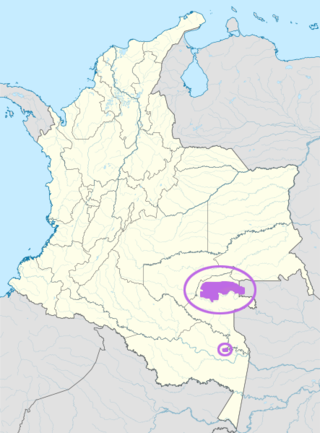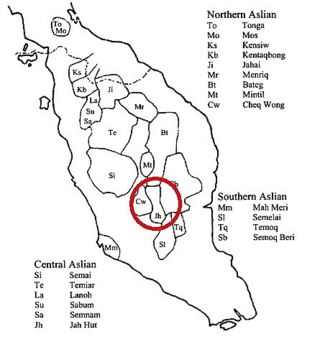Related Research Articles

The Semang are an ethnic-minority group of the Malay Peninsula. They live in mountainous and isolated forest regions of Perak, Pahang, Kelantan and Kedah of Malaysia and the southern provinces of Thailand. The Semang are among the different ethnic groups of Southeast Asia who, based on their dark skin and other perceived physical similarities, are sometimes referred to by the superficial term Negrito.
In phonetics, nasalization is the production of a sound while the velum is lowered, so that some air escapes through the nose during the production of the sound by the mouth. Examples of archetypal nasal sounds include and.

The Aslian languages are the southernmost branch of Austroasiatic languages spoken on the Malay Peninsula. They are the languages of many of the Orang Asli, the aboriginal inhabitants of the peninsula. The total number of native speakers of Aslian languages is about fifty thousand and all are in danger of extinction. Aslian languages recognized by the Malaysian administration include Kensiu, Kintaq, Jahai, Minriq, Batek, Cheq Wong, Lanoh, Temiar, Semai, Jah Hut, Mah Meri, Semaq Beri, Semelai and Temoq.
Semai is a Austroasiatic language of western Malaysia spoken by about 60,438 Semai people. It is one of the few Aslian languages which are not endangered, and even has 2,000 monolingual speakers. It is currently spoken by 3 main groups; the Northern Semai, Central Semai and the Southern Semai.
The Northern Aslian languages are a group of Aslian languages spoken by about 5,000 people in inland areas of Peninsular Malaysia, with a few pockets in southern Thailand. The most distinctive language in the group is the outlier Cheq Wong, which is spoken south of the Central Aslian language Semai. The other languages apart from Tonga can be split into two divisions:

The Mah Meri are an ethnic group native to western part of Peninsular Malaysia. They are one of the 18 Orang Asli groups named by the Malaysian government. They are of the Senoi subgroup. Most of the members of the Mah Meri tribe live along the coast of South Selangor from Sungai Pelek up to Pulau Carey, although there is at least one Mah Meri Community on the other side of the Klang River.
The Southern Aslian languages are a sub-branch of the Aslian branch of the Austroasiatic language family. They have also been referred to as the Semelaic languages, but this label is no longer used. The four languages that make up the branch are:
The phonology of Sesotho and those of the other Sotho–Tswana languages are radically different from those of "older" or more "stereotypical" Bantu languages. Modern Sesotho in particular has very mixed origins inheriting many words and idioms from non-Sotho–Tswana languages.
Semelai is an Austroasiatic language spoken in the Malay Peninsula. It belongs to the Southern branch of the Aslian language subgrouping. The Semelai reside predominantly around the Bera, Serting and associated river systems in the states of Pahang, Negeri Sembilan and Johor.
Mundari (Munɖari) is a Munda language of the Austroasiatic language family spoken by the Munda tribes in eastern Indian states of Jharkhand, Odisha and West Bengal. It is closely related to Santali. Mundari Bani, a script specifically to write Mundari, was invented by Rohidas Singh Nag. It has also been written in the Devanagari, Odia, Bengali, and Latin writing systems.
Shompen, or Shom Peng is a language or group of languages spoken on Great Nicobar Island in the Indian union territory of the Andaman and Nicobar Islands, in the Indian Ocean, northwest of Sumatra, Indonesia.
Pnar, also known as Jaiñtia is an Austroasiatic language spoken in India and Bangladesh.
Kensiu (Kensiw) is an Austro-asiatic language of the Jahaic subbranch. It is spoken by a small community of 300 in Yala Province in southern Thailand and also reportedly by a community of approximately 300 speakers in Western Malaysia in Perak and Kedah states. Speakers of this language are Negritos who are known as the Mani people or Maniq of Thailand.

The Cubeo language is the language spoken by the Cubeo people in the Vaupés Department, the Cuduyari and Querarí Rivers and their tributaries in Colombia, and in Brazil and Venezuela. It is a member of the central branch of the Tucanoan languages. Cubeo has borrowed a number of words from the Nadahup languages, and its grammar has apparently been influenced by Arawak languages. The language has been variously described as having a subject–object–verb or an object–verb–subject word order, the latter very rare cross-linguistically. It is sometimes called Pamiwa, the ethnic group's autonym, but it is not to be confused with the Pamigua language, sometimes called Pamiwa.

Jah Hut is an Austroasiatic language spoken around the Krau river in peninsular Malaysia. The Jah Hut are one of the indigenous Orang Asli peoples.
Mah Meri, also known as Besisi, Cellate, Hma’ Btsisi’, Ma’ Betisek, and “Orang Sabat”, is an Austroasiatic language spoken in the Malay Peninsula. Along with Semaq Beri, Semelai and Temoq, Mah Meri belongs to the Southern Aslian branch of the Aslian languages. Mah Meri is the only remaining Aslian language spoken in a coastal area and its speaker population is 3,675 as recorded at the Orang Asli Museum in Gombak. A dictionary of the Mah Meri language has been compiled by Nicole Kruspe.
Jahai (Jehai) is an aboriginal Mon–Khmer language spoken by the Jahai people living in the montane rainforests of northern Peninsular Malaysia and southernmost Thailand. It is the largest Northern Aslian language. Though spoken by only a little more than 1,000 people, Jahai does not appear to be in immediate danger of extinction due to the prevalence of Jahai parents passing on the language to their children as their mother tongue.

Cheq Wong is an Austroasiatic language spoken in the Malay Peninsula by the Cheq Wong people. It belongs to the Northern subbranch of the Aslian languages. Northern Aslian was labelled Jehaic in the past.
Ten'edn, also known as Mos in Thailand and Tonga-Mos or just Tonga in some literature, is an aboriginal Mon–Khmer language spoken by the Maniq tribe of Thailand and Malaysia.
Kintaq, or Kentaq Bong, is an Austroasiatic language spoken in Malaysia and Thailand. It belongs to the Northern Aslian sub-branch of the Aslian languages. The small number of speakers is decreasing.
References
- 1 2 3 4 5 6 7 Yager & Burenhult (2017)
- ↑ "Language previously unknown to linguists discovered in Southeast Asia". ScienceDaily. 6 February 2018. Retrieved 10 February 2018.
- ↑ "Unknown Language Discovered in Malaysia". Smithsonian. 9 February 2018. Retrieved 10 February 2018.
- Yager, Joanne; Burenhult, Niclas (2017). "Jedek: A newly-discovered Aslian variety of Malaysia" (PDF). Linguistic Typology. 21 (3): 493–545. doi:10.1515/lingty-2017-0012. hdl: 11858/00-001M-0000-002E-7CD2-7 . S2CID 126145797 – via deGruyter.